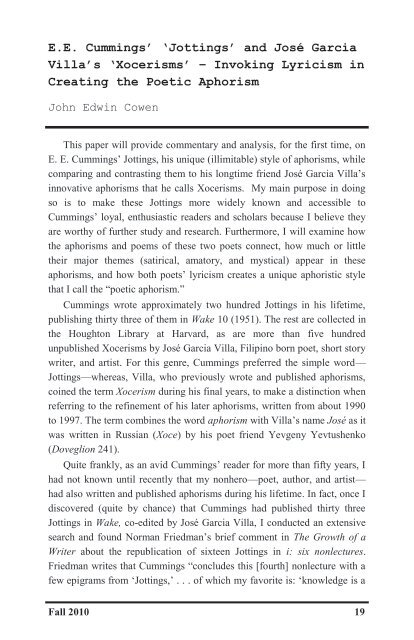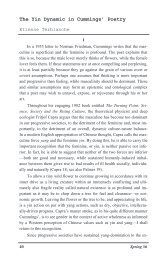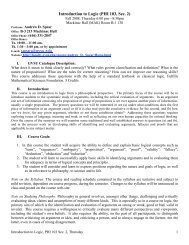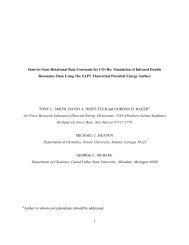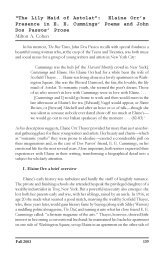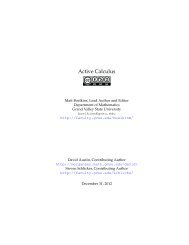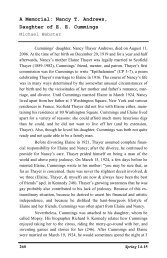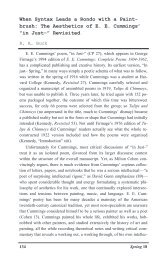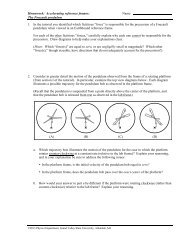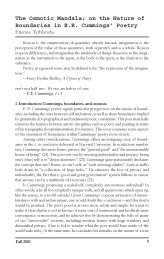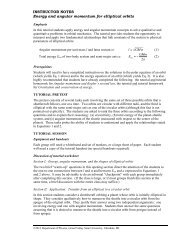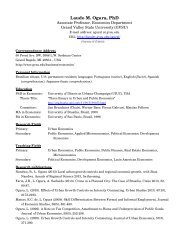E.E. Cummings' 'Jottings' and José Garcia Villa's 'Xocerisms ... - Gvsu
E.E. Cummings' 'Jottings' and José Garcia Villa's 'Xocerisms ... - Gvsu
E.E. Cummings' 'Jottings' and José Garcia Villa's 'Xocerisms ... - Gvsu
Create successful ePaper yourself
Turn your PDF publications into a flip-book with our unique Google optimized e-Paper software.
E.E. Cummings’ ‘Jottings’ <strong>and</strong> José <strong>Garcia</strong>Villa’s ‘Xocerisms’ – Invoking Lyricism inCreating the Poetic AphorismJohn Edwin CowenThis paper will provide commentary <strong>and</strong> analysis, for the first time, onE. E. Cummings’ Jottings, his unique (illimitable) style of aphorisms, whilecomparing <strong>and</strong> contrasting them to his longtime friend José <strong>Garcia</strong> Villa’sinnovative aphorisms that he calls Xocerisms. My main purpose in doingso is to make these Jottings more widely known <strong>and</strong> accessible toCummings’ loyal, enthusiastic readers <strong>and</strong> scholars because I believe theyare worthy of further study <strong>and</strong> research. Furthermore, I will examine howthe aphorisms <strong>and</strong> poems of these two poets connect, how much or littletheir major themes (satirical, amatory, <strong>and</strong> mystical) appear in theseaphorisms, <strong>and</strong> how both poets’ lyricism creates a unique aphoristic stylethat I call the “poetic aphorism.”Cummings wrote approximately two hundred Jottings in his lifetime,publishing thirty three of them in Wake 10 (1951). The rest are collected inthe Houghton Library at Harvard, as are more than five hundredunpublished Xocerisms by José <strong>Garcia</strong> Villa, Filipino born poet, short storywriter, <strong>and</strong> artist. For this genre, Cummings preferred the simple word—Jottings—whereas, Villa, who previously wrote <strong>and</strong> published aphorisms,coined the term Xocerism during his final years, to make a distinction whenreferring to the refinement of his later aphorisms, written from about 1990to 1997. The term combines the word aphorism with Villa’s name José as itwas written in Russian (Xoce) by his poet friend Yevgeny Yevtushenko(Doveglion 241).Quite frankly, as an avid Cummings’ reader for more than fifty years, Ihad not known until recently that my nonhero—poet, author, <strong>and</strong> artist—had also written <strong>and</strong> published aphorisms during his lifetime. In fact, once Idiscovered (quite by chance) that Cummings had published thirty threeJottings in Wake, co-edited by José <strong>Garcia</strong> Villa, I conducted an extensivesearch <strong>and</strong> found Norman Friedman’s brief comment in The Growth of aWriter about the republication of sixteen Jottings in i: six nonlectures.Friedman writes that Cummings “concludes this [fourth] nonlecture with afew epigrams from ‘Jottings,’ . . . of which my favorite is: ‘knowledge is aFall 2010 19
polite word for dead but not buried imagination’ ” (183). One might readilycompare this Jotting on knowledge to the first line in Cummings’ wellknownpoem “since feeling is first” (CP 91). Both illustrate one of hisrecurring themes: that to merely exist is equal to being dead. The compactlyrical meaning in this aphorism is implied rather than didactic, creating anextended metaphor of unfeeling (pedantry) versus feeling (creativity),juxtaposing knowledge (death) with not buried imagination (living human).This Jotting thus illustrates the poetic aphorism’s essential characteristics:an inherent use of metaphor, the rearrangement of word order, <strong>and</strong> attentionto lyrical sound value, characteristics which are uniquely evident inCummings’ Jottings <strong>and</strong> Villa’s Xocerisms. Furthermore, these poeticaphorisms are in direct contrast to what D. H. Lawrence calls “nagging”prose thoughts or pensées—like those written by Pascal or La Bruyere.Lawrence writes: “There is a didactic element about prose thoughts whichmakes them repellent, slightly bullying” (v). The above Jotting is far fromirritating or nagging; instead, it is provocative, while at the same time,transfixing <strong>and</strong> engaging, thereby awakening the imagination of the reader.Before ending nonlecture four with this Jotting, Cummings reads twoothers which strike a very similar note on what it is to be natural in a worldof false effects: “an intelligent person fights for lost causes,realizing thatothers are merely effects” <strong>and</strong> “think twice before you think” (six 70;Miscellany 331). In Cummings’ words, “lost causes” are only lost in theminds of “most people” like politicians, who fail to fight for lost causes, ashe contentiously voiced in his most vitriolic poem, THANKSGIVING(1956), which Friedman characterized as an “attack on America’s officialindifference to the Soviet suppression of the Hungarian revolution”(Growth 113). In response to the old adage to “think before you act,”Cummings would counter, “act before you think,” or you may not act at all.Somewhere in the sixties, I read i: six nonlectures but did not recognizethe significance of Cummings’ poetic aphorisms at that time. I prefer theterm aphorism over Friedman’s term epigram because I agree with NewYorker critic George Steiner, who wrote: “Almost by definition, <strong>and</strong> evenwhere it sticks strictly to colloquial prose, the aphorism nears the conditionof poetry. Its formal economy aims to startle in a flash of authority; it aimsto be singularly memorable, as does a poem” (152).In 2008 I edited Doveglion: Collected Poems, which gathers the best ofJosé <strong>Garcia</strong> Villa’s poetry (long out of print), <strong>and</strong> which publishes for thefirst time Villa’s Xocerisms (244-260), as well as describing for the first20 Spring 17
time a new versification system that Villa called Duo-Technique (228-243).Once, when Villa’s aphorisms were compared to Pascal’s, he quicklyretorted: “Don’t compare Pascal’s Pensées to mine—which I now callXocerisms—pithy, inventive, philosophical insights told with a dash ofTabasco” (Doveglion 241). Villa believed in the importance of theaphorism <strong>and</strong> thought these Xocerisms would add to his legacy. In defininghis poetic aphoristic style, Villa boasted, “My Xocerisms probe the ethic,philosophic force behind all essential living. And I do this in just one, twoor three sentences at most” (Doveglion 242). Two Xocerisms that parallelCummings’ theme that imagination <strong>and</strong> feeling are first, transcending mereknowing, are numbers 18 <strong>and</strong> 96:To read between the lines is Logic.To read between the lines when there are no lines is Imagination (246)[<strong>and</strong>]Reason is merely connecting the dots but intelligenceis the creation of those dots (253)The brevity of style <strong>and</strong> the probing philosophic themes that Villadescribes can be found in most of his Xocerisms <strong>and</strong> in Cummings’Jottings. In fact, employing Friedman’s technique of grouping Cummings’writings thematically, I discovered that 27 of the 33 poetic aphorisms inWake can be classified as “transcendental.” Similarly, Friedman’s thematicanalysis shows that by 1950—the year Xaipe was published <strong>and</strong> just oneyear before Wake 10 appeared—there was a decline in Cummings’ satiricalpoems in favor of his more transcendental / mystical <strong>and</strong> love poems(Growth 152-162). I suspect that as the maturing poet’s mystical visionevolved in creating his later poems, he continued probing the inner-self <strong>and</strong>extolling individualism, the dominant theme found in his Jottings.However, for the most part the theme of love is not pursued in his Jottings.There is a similar concentration on transcendental, mystical themes inthe 150 Xocerisms published in Doveglion. In fact, Villa published manydivine <strong>and</strong> mystical poems in his first U. S. book, Have Come, Am Here(1942), poems which humanize God. As English writer Sylvia TownsendWarner wrote: “It is like seeing orchids growing wild to read him…Since Imet him he seems to have met God; but a God so much in his own imagethat I am sure no harm can come of the encounter” (Doveglion xxiv).For his nonlectures, Cummings chose to read only 16 of the 33 Jottingspublished in Wake 10, while also rearranging their order. Choosing to readthese Jottings at the end of this important fourth nonlecture, whichFall 2010 21
Cummings called “an exploration of his stance as a writer” (six 63), isproof that the poet thought highly of these relatively new poetic aphorisms.He introduces the reading of these aphorisms by saying that they are “froman essay entitled Jottings, published in Wake magazine [1951]” (70).Cummings’ choice of the words “from an essay” is somewhat confusing, ifnot misleading, given that his Jottings in Wake are separate aphorismsnumbered 1 through 33 <strong>and</strong> in no apparent order. On the other h<strong>and</strong>, it ispossible that Cummings planned to write an essay; these loosely structuredJottings could eventually be reassembled to create an essay. Perhaps this isone meaning of the sentence in the second paragraph of nonlecture four thatreads: “Suffice it to say that the present non-poetical period will consist ofnothing but sentences, essays, <strong>and</strong> parts of essays, all of which express ast<strong>and</strong>ing human being” (63, my emphasis). Or perhaps “Jottings”deconstructs <strong>and</strong> fragments the traditional idea of an essay just ascompositions like “l)a” (CP 673) deconstruct <strong>and</strong> fragment the traditionalidea of a poem.Villa edited the widely read 1946 Cummings Number of the HarvardWake, <strong>and</strong> now in 1951 Villa published Cummings’ Jottings in the renamedWake—shortly after publishing his own aphorisms for the first time in his1949 collection of poems called Volume Two. This appearance ofCummings’ Jottings in Villa’s Wake just two years after Volume Twosuggests that perhaps it was Villa who influenced Cummings’ writing ofaphorisms. However, Villa proclaimed that it was Cummings’ lyrical <strong>and</strong>experimental poetry that influenced him to ab<strong>and</strong>on writing the short storyfor good in favor of poetry, stating: “If I learned to write poetry at all, itwas by studying principally the work of E. E. Cummings” (qtd. in Cowen,“Lyricism” 82). One of Villa’s most poetic aphorisms, about theimportance of craft in writing a poem, is one I feel Cummings would havegreatly approved: Villa’s Xocerism # 49 reads:A poemislanguagebuiltto thestructureof aflower. (Doveglion 249)I present here the versified version in two, four-lined stanzas that Villawrote in the margin of his notebook, but as a Xocerism it seems to maintain22 Spring 17
its sound value written as straight-line prose: “A poem is language built tothe structure of a flower” (Doveglion 248). However, in discussing WilliamCarlos Williams’ famous free verse poem “The Red Wheelbarrow,” DanaGioia writes that it is “…the visual placement of those sounds on the page”that creates an aesthetic harmony of aural/visual imagery. Gioia maintainsthat Williams’ language loses its sound value once it is written as twodiscreet lines of prose (35):so much depends upon a red wheel barrowglazed with rain water beside the white chickensMy point here is that Villa demonstrates how the pitch of language,borrowed from lyricism, is used to advantage by employing the poeticaphorism. Hence, the poetic dimension remains—sound value = poetic =lyrical.This argument is amplified once more by Villa’s charming Xocerism,number 64, “A poem is not a thought, but a grace” (250). In other words,even the quality of language of a prose statement can be heightened to alyrical pitch by the choice of words, syntax <strong>and</strong> punctuation, or by carefullyselecting <strong>and</strong> reassembling words for their sound value as much as for theirthought or expression. Cummings employs punctuation, notably theparentheses, to sculpt movement <strong>and</strong> meaning in his poetry. Jotting # 13,published in Wake but not in six nonlectures, makes canny use of theparentheses:of course Bacon wrote Shakespeare;but so did everybodyelse,including(luckily) Shakespeare(Miscellany 330)While researching Cummings’ Jottings at Houghton Library, Idiscovered that he had typed out an earlier version without the word“luckily” enclosed in parentheses. Without this insertion, the line readsfaster, resulting in a flat, ordinary prose statement, which, in turn, lacksCummings’ witty, lyrical conclusion.Cummings’ Jotting # 12 in Wake consists of just two words—“hatredbounces”—<strong>and</strong> produces a modernist poetic effect much like what JamesMerrill described as “English in its billiard-table sense—words that havebeen set spinning against their own gravity” (qtd. in McClatchy 49).Together, both words transcend immediacy of underst<strong>and</strong>ing, dem<strong>and</strong>ingthat the reader re-examine their meaning, asking for example: “Why doesFall 2010 23
hatred bounce?” “Where does it bounce to?” “What are its effects?” Theseare transcendental considerations caused by the juxtaposition of twoseemingly simple words, which transparently form a metaphor, a figurativedevice found in most Cummings’ <strong>and</strong> Villa’s poems, <strong>and</strong> now, once again,in their poetic aphorisms. In an article on satire <strong>and</strong> prejudice inCummings’ poetry Michael Webster cites a 1955 letter to Ezra Pound inwhich the poet quotes this Jotting in order to warn “Pound about thedifficulties of controlling an emotion like hatred” (32). Webster speculatesthat Cummings may have composed this Jotting after his own experiencewith the accusations of anti-Semitism occasioned by his controversial poem“a kike is the most dangerous” (CP 644). Webster writes that the “hatredlatent in the charged word [in the first line of the poem] bounces right backdespite the poet’s intent to satirize what he saw as the process of prejudiceformationitself” (32). Webster further notes how Cummings’ letter toPound refers to the biblical story of David <strong>and</strong> Goliath as an example of anattack that did not bounce back because, as Cummings says, “Joy is thename of a brook” from which David chose the “five smooth stones” to hurlat Goliath (Letters 243). These stones, having their source in Joy, did notbounce like hatred; rather, they “sank into [Goliath’s] forehead, <strong>and</strong> he fellon his face to the ground’ ” (1 Samuel 17:49; qtd. in Webster 33).Similarly, Villa’s brief Xocerism # 108 has the effect of “setting wordsspinning” <strong>and</strong> inviting the reader to make new connections:H-O-M-O S-A-P…Stop Right There! (255)In this case a two-word phrase is cut short, turning “Homo Sapiens” into“Homo Sap,” a pun reminiscent of Cummings’ more satirical (wise-guy)poems written about “mostpeople.” In addition, Villa’s aphorism asks us towonder just what sort of (un)wise saps these human beings might be.It is typical of Cummings to use various combinations of comparative<strong>and</strong> superlative adjectives in his poetry like “mostpeople” versus“somepeople” which, according to Norman Friedman, is used “for an effectof constant choosing, preferring, discriminating, of overtopping the best<strong>and</strong> the worst, <strong>and</strong> of the transcendence of extremes” (Art 70). Cummings’use of comparative <strong>and</strong> superlative adjectives shows up in the Jottings thatare numbered 1 <strong>and</strong> 2 in nonlecture four but 28 <strong>and</strong> 31 in the Wakecompilation. These two Jottings praise the real individual—the artist or thepoet—who st<strong>and</strong>s above all others, <strong>and</strong> who is not merely an equal.24 Spring 17
equality is what does not exist among equals [<strong>and</strong>]most people are perfectly afraid of silence(six 70; Miscellany 331)In Cummings, the superlative individual requires silence to imagine, tobe reflective <strong>and</strong> creative, whereas mostpeople dread freedom (silence) toponder meaning or to be self-reflective. Villa’s similar view that difficultsilence <strong>and</strong> reflection are the requisites for internalizing <strong>and</strong> creating is bestexpressed in Xocerisms numbers 99 <strong>and</strong> 98:Hard decisions are not in quiet made, but in turmoiling stillness. (254)[<strong>and</strong>]Monks do not bait themselves with fatuous mundane dreams, but live inabstract, painful peace. (254)Both Cummings <strong>and</strong> Villa rail against the use of clichés, most evident inVilla’s witty, chiding Xocerism number 150:CLICHES: The common hussies of language—the bimbos. (259)Two Jottings in nonlecture four parody well-known prosaic adages byemploying word play, effectively changing the original’s moralistic tone,demonstrating how the poetic aphorism can create a satirical edge, as wellas the element of surprise:people who live in steel houses should pull down the lightning[<strong>and</strong>]the pigpen is mightier than the sword(six 70; Miscellany 331)Like Cummings, Villa believed that form follows function in art <strong>and</strong>poetry, <strong>and</strong> it is the craft of poetry that employs structural innovations suchas distorting syntax <strong>and</strong> employing punctuation to create effects that makeart from words that detain <strong>and</strong> engage the reader to find new <strong>and</strong>unsuspected meanings. As he writes in numbers 35 <strong>and</strong> 42:Form is to Substance what a wet T-Shirt is to a fine body. (247) [<strong>and</strong>]Art is a miraculous flirtation with Nothing!Aiming for nothing, <strong>and</strong> l<strong>and</strong>ing on the Sun. (248)Fall 2010 25
Villa despised poetry written by a species of poets he called peots whowrote mundane prose “chopped into lines” as he scoffed. In Have Come,Am Here (1942), Villa wrote, “First, a poem must be magical, / thenmusical” (12), <strong>and</strong> both he <strong>and</strong> Cummings condemned poorly craftedpoetry. Villa does so wittily in Xocerism number 75:They who, with all good will, use language as an instrument of torture.(251)One of Cummings’s Jottings, a favorite of mine, at first reading revealsonly the obvious—that the penguin’s wings are to swim with—implyingthat the wings of this strange bird are not used for flying. But this penguinis a poet, requiring the reader to think twice before thinking:a poet is a penguin—his wings are to swim with(six 70; Miscellany 330)Note also the lyrical use of alliteration such as the p in poet <strong>and</strong> penguin,the w in wings <strong>and</strong> with, <strong>and</strong> the assonance of short “i” in is, his, swim,with—all in just eleven words.Cummings, like Villa, believed that the poet is an “odd bird” whoperforms the unexpected, even the bizarre. As Villa once wrote, “I am afreak. I am part male, part female <strong>and</strong> part child—the freakish me is theessence of me—the artist aloof <strong>and</strong> at play” (qtd. in Cowen, “Cummings /Villa” 104). While Villa’s remark stresses the freakish nature of the poet,Cummings stresses more “the artist aloof <strong>and</strong> at play” in his poet-aspenguinimage. In writing about Cummings as a lyric poet, Friedman notes:“It seems to me that Cummings’ interest in people—<strong>and</strong> especially thosewho are strangers in society or who are creative in some special way—hasnot been sufficiently remarked” (Growth 130). One of these so-called“strangers in society” is the clown, comparable to the penguin-poet image,a freak who should be revered like the tramp or the street poet—JoeGould—who is immortalized in Cummings’ poem “little joe gould has losthis teeth <strong>and</strong> doesn’t know where” (CP 410). An imagistic Jotting,published in Wake but not included in the nonlectures, describes a clown:the expression of a clown is mostly in his knees (Miscellany 330)Why his knees? Because Cummings—the poet-impressionistic-artist—can26 Spring 17
visualize that the baggy-knee-pants of a clown mirror his frown <strong>and</strong>, likehis poems, Cummings’ Jottings create magical images that paint portraits.Another of Cummings’ impressionistic Jottings, published in Wakeonly, is worth considering, at this juncture, especially because we, too, havecome to the end of this particular nonlecture:ends are beginnings with their hats on (Miscellany 330)It is my hope that this short consideration of these Jottings <strong>and</strong>Xocerisms will show that everything great poets write is of importance,especially when they continue to grow <strong>and</strong> experiment, transcending eventheir best poetry by “…h<strong>and</strong>l[ing] words with supreme virtuosity—the kindof virtuosity that makes the words themselves come alive” (Schonberg341). I’ll end this paper with a challenge from one of Cummings’unpublished Jottings at the Houghton Library:nothing which can be measured has the slightest significanceI invite the reader (<strong>and</strong> possibly the writer) to measure something—thatis, as if you knew less before the after of the now of this paper.Works Cited—Fairleigh Dickinson University, Teaneck, New JerseyAhearn, Barry, ed. Pound / Cummings: The Correspondence of Ezra Pound<strong>and</strong> E. E. Cummings. Ann Arbor: U of Michigan P, 1996.Cowen, John Edwin. “E. E. Cummings’ Lyricism Today.” Spring: TheJournal of the E.E. Cummings Society New Series 5 (1996): 82-89.—. “Doveglion: The E.E. Cummings / José <strong>Garcia</strong> Villa Connection.”Spring New Series 10 (2001): 102-109.Cummings, E.E. Complete Poems, 1904-1962. Ed George J. Firmage. NewYork: Liveright, 1994.—. “Jottings.” Wake 10 (1951): 81-83. Rpt. in E. E. Cummings: A MiscellanyRevised. Ed. George J. Firmage. New York: October House,1965. 330-332.—. i: six nonlectures. Cambridge: Harvard UP, 1953.—. Selected Letters of E. E. Cummings. Ed. F.W. Dupee <strong>and</strong> George Stade.New York: HBJ, 1969.Fall 2010 27
Lawrence, D. H. Pansies: Poems. New York: Alfred A. Knopf, 1931.Friedman, Norman. E. E. Cummings: The Art of His Poetry. Baltimore:Johns Hopkins UP, 1960.—. E. E. Cummings: The Growth of a Writer. Carbondale: Southern IllinoisUP, 1964.Gioia, Dana. Can Poetry Matter? Essays on Poetry <strong>and</strong> American Culture.New York: Graywolf P, 1992.McClatchy, J. D. “Postscript: Braving the Elements.” The New Yorker (27March 1995): 49-52, 59-61.Schonberg, Harold C. “Captions by Cummings.” Rev. of Adventures inValue by E. E. Cummings <strong>and</strong> Marion Morehouse. New York TimesBook Review (25 Nov. 1962): 341.Steiner, George. “Short Shrift.” The New Yorker (16 April 1984): 152-157.Villa, José <strong>Garcia</strong>. Doveglion: Collected Poems. Ed. John Edwin Cowen.Intro. Luis H. Francia. New York: Penguin, 2008.—. “Memoir of E. E. Cummings.” Spring: The Journal of the E.E. CummingsSociety Old Series 4.1 (April 1984):13-17.—. Have Come, Am Here. New York: Viking Press, 1942.—. Volume Two. New York: New Directions, 1949.—. Selected Poems <strong>and</strong> New. New York, 1958.Webster, Michael. “‘hatred bounces’: Satire <strong>and</strong> Prejudice in the Poetry ofE. E. Cummings.” Spring: The Journal of the E. E. Cummings SocietyNew Series 7 (October 1998): 23-38.28 Spring 17


